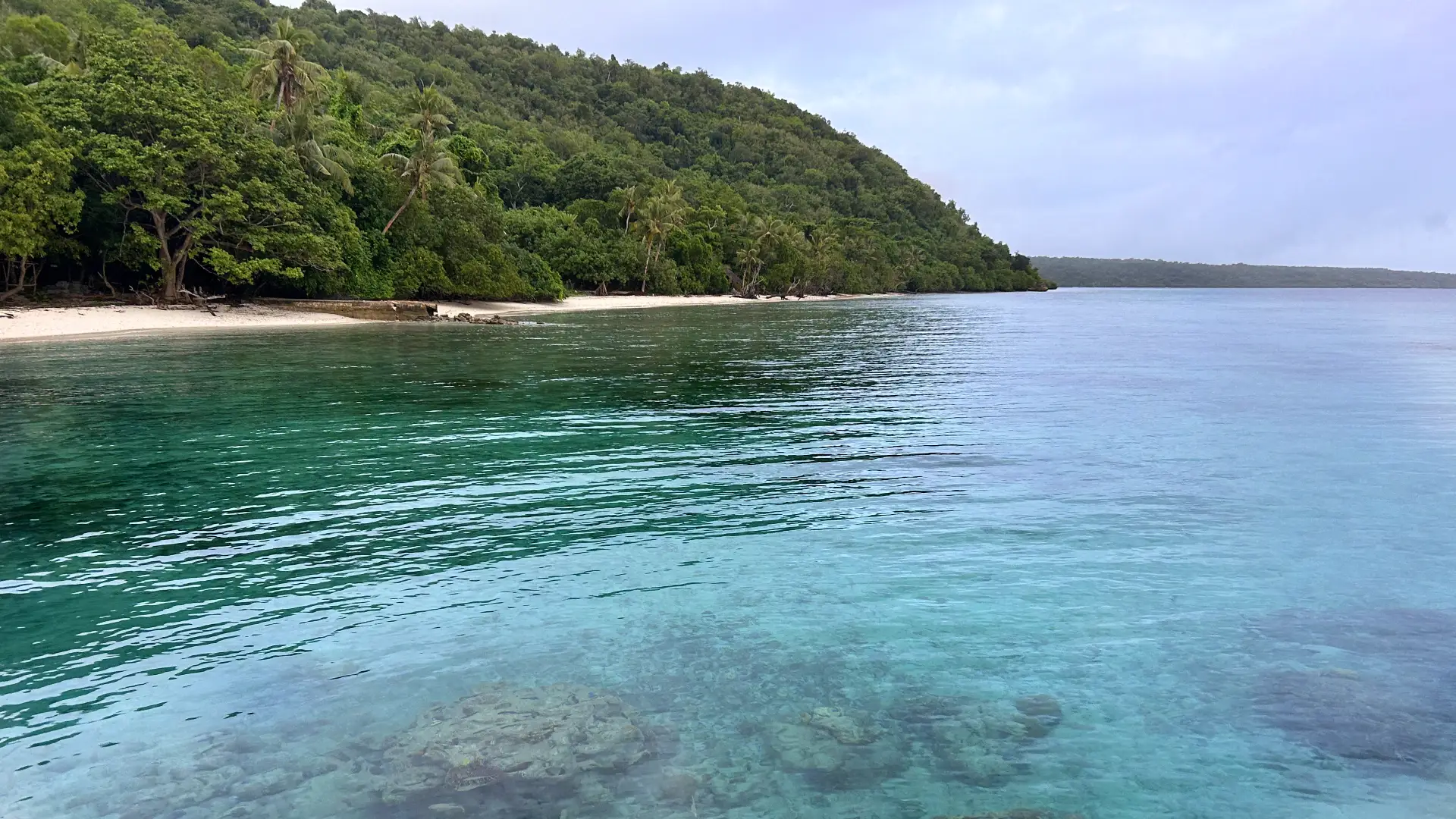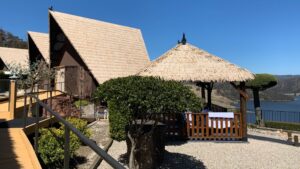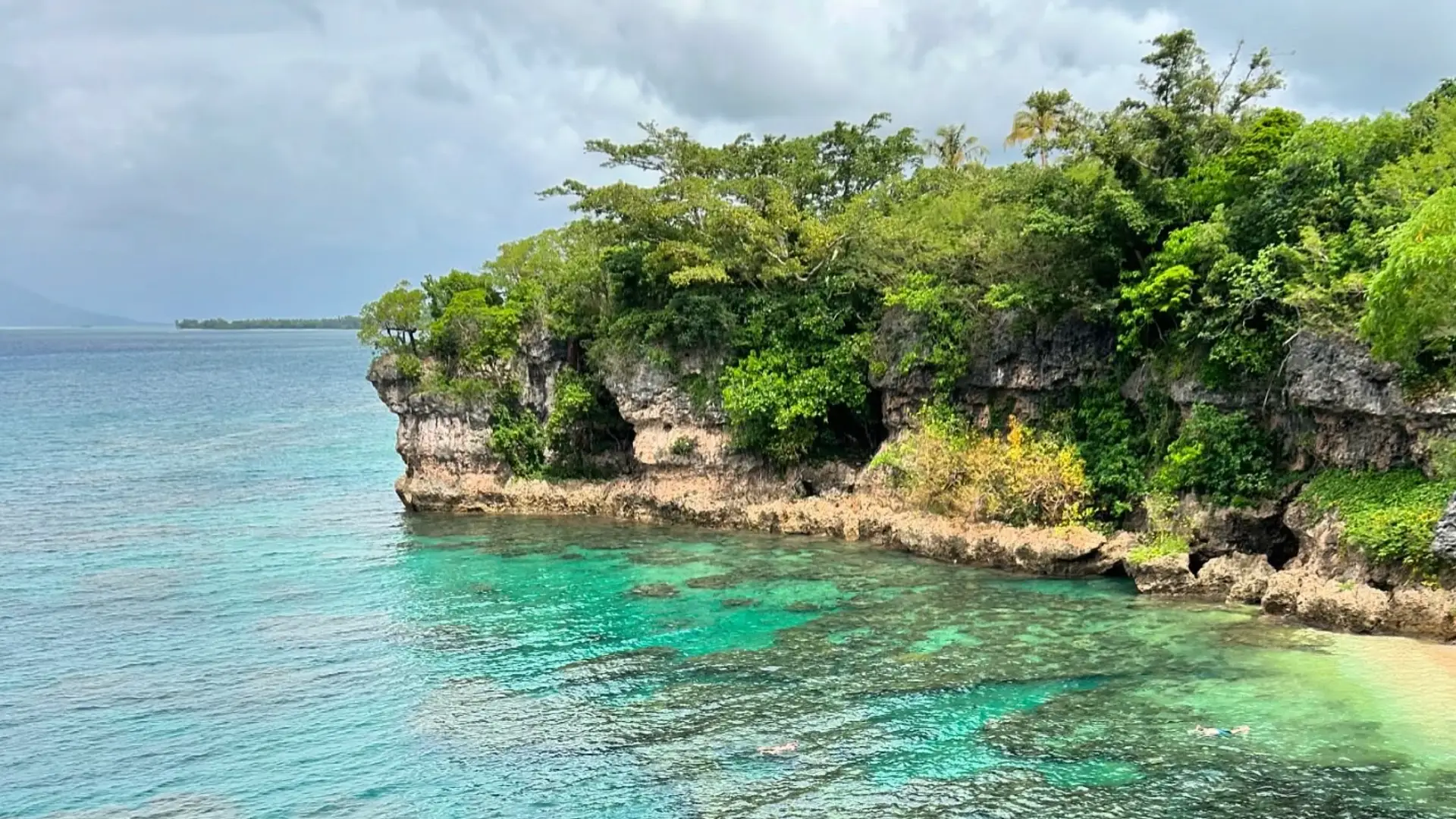After taking advantage of an incredibly cheap Jetstar sale that got us to Darwin for just $18, we had three days to make the most of our time in the Top End. So, we divided our time and spend a day in Darwin followed by a two-day Litchfield itinerary exploring the area’s natural wonders for the ultimate Top End weekend.
We knew we wanted to visit one of the area’s renowned national parks and to make the most of the natural wonders in the area.
But, just deciding between Litchfield National Park and Kakadu National Park probably took us more time than we actually had on holiday. In the end, a Litchfield itinerary won and we’re pretty happy with our decision.
Why did we chose Litchfield vs Kakadu for our Top End trip?
While both certainly had their pros, we were travelling during the wet season and only had two days to explore.
Much of Kakadu becomes hard to visit during the wet season, especially when you’re relying on a hire car that isn’t a 4WD. Not only is Litchfield closer to Darwin, distances between attractions in the park are much shorter.
TL;DR: 3-day Darwin and Litchfield itinerary in a nutshell
- Where is it? The northern part of the Northern Territory, this weekend was spent mostly at Litchfield National Park and near Darwin
- Price: Litchfield National Park is $10 per day to visit with a parks pass. Jumping Crocodile Cruises are $53 per adult. All other activities mentioned in this itinerary are included with the parks pass or free. (Except for any food purchased)
- What to do and see: Litchfield National Park’s Magnetic Termite Mounds, Florence Falls, The Cascades, Wangi Falls and the Adelaide River
- When to go: During the dry season: late autumn, winter or early spring (We travelled in February as it was when we got cheap flights, but it’s hotter and wetter to travel then.)
Skip down to… What to do | Where to stay | Where to eat | How to get there
What to add to a Darwin and Litchfield itinerary
After landing in Darwin close to midnight on a Friday night, we weren’t about to drive out of the city and to a national park. We spent our first night at the conveniently located and budget friendly Capitanos Hotel in the CBD.
Day 1: Darwin
Starting the day early to try and avoid the wet season’s humidity, the day started with a stroll along the harbour in Bicentennial Park. The green patch along the CBD’s southwest shore provides little-but-lush outlooks to the harbour’s aquamarine waters and little insights to Darwin’s past with placards along the path detailing much of the NT capital’s history.
Eventually, the path will turn into The Esplanade, which will lead you to Darwin’s rejuvenated waterfront area. If we had more time in the area, we probably would have taken a dip at the artificial (and stinger-free!) beach or jumped into the wave pool ($8).

Carrying on to the streets of the CBD, you’ll find yourself spoiled for choice for a cafe to grab some breakfast. We picked The Rabbithole and it was like stepping into a cute Melbourne cafe.
After breakfast, a stroll into some of the local art galleries was a real treat. Stunning, unique pieces by local indigenous artists can be found here and nowhere else in the world. Each piece comes with a story attached, and we left with a beautiful piece of yellow bush leaves.

Before leaving the city for Litchfield National Park, a stop at the Museum and Art Gallery of the Northern Territory gave some great insights to the local life and culture. (Plus, we got incredibly lucky as a downpour started just as we arrived, and was finished by the time we left.)
Driving to Litchfield
After an hour-long drive to Batchelor from Darwin, we arrived in the early evening to the gateway to Litchfield National Park. While it can be easily visited as a day trip from the city, we wanted to spend extra time in the park so decided to spend the next two nights in the park to spend as much time in the park as possible.
(Note: We would recommend stopping at a supermarket along the way for any fresh food or snacks. There’s only one small shop in Batchelor, which doesn’t even sell as much as most petrol stations would.)
The largest “town” (of sorts) near Litchfield is Batchelor, and it’s the last place you’ll find petrol or a shop before entering the park. Conveniently, both were located at our hotel: Litchfield Outback Resort, where we also grabbed dinner that evening.
Day 2: Litchfield National Park
When visiting tropical places like the Top End where the midday heat and sun can be relentless, starting early is best. So we started our day at about 7am and were on the road soon after.

Magnetic Termite Mounds
Our first stop on our Litchfield itinerary, the Magnetic Termite Mounts are only about 30 minutes outside of Batchelor. These curious structures are certainly not everyone’s cup of tea, but they were ours. Reaching a few metres tall, they’re huge mounds built by local termites. The most impressive ones being the gravestone-like magnetic termite mounds, which are actually all designed to keep the mound cool by minimising exposure to the sun.
Recommended? Yes, especially if you’re a bit of a science nerd.
Continuing on, Buley Rockhole and Florence Falls are both within close proximity to each other and actually have a walking track between the two. We wanted to squeeze in some extra nature time, so opted to take the easy stroll between the two.
While it hadn’t been raining the day we visited, due to heavy rains in the days before we arrived, both Florence and Buley were closed for swimming. But, they’re usually some of the few places in the park that are open for dips year-round.
Recommended? Yes, even if we weren’t able to swim, they were beautiful places to see.

Tolmer Falls
Travelling further southwest on Litchfield Park Road, the Tolmer Falls lookout and creek was next on our agenda. Unlike Florence and Wangi Falls (the latter we’ll get to in a bit!), this towering cascade doesn’t seem to make it into quite as many brochures. For what reason, we’re not sure!
Taking the 1.5-km Tolmer Falls Creek Walk had an incredible build-up to the main event. The closer you get, the more of a roar you hear as the white water makes its way to the edge of the rust-red cliffs. The bush track eventually met up with the accessible path to the lookout, where we were treated to views of the narrow falls tumbling off a cliff face into a deep-blue pool at the bottom that, as inviting as it looks, was forbidden to swimmers.
Recommended? Yes.

Three waterfalls in, but our tour wasn’t even close to done yet.
Green Creek Walk to Tjaetaba Falls
Seeing a sign for a walk that wasn’t on out list got us curious. So we pulled over at a car park for the Greenant Creek Walk to Tjaetaba Falls. (Plus, we were curious to see if we could spot the insect that’s been known as a bush food — but please don’t just go and try it without knowing what you’re doing!)
This barely 3km walk ended up being one of our favourites. Shady monsoonal forests were lush with tropical, green foliage and those made way to more classic Northern Territory-landscapes as we climbed toward the top of the falls. While it wasn’t a spot we were able to swim, the shallow pool at the top of the falls didn’t have a strong current and was just perfect for dipping toes into after the hot climb up. After all, it was the middle of the day in the Top End summer.
Recommended? Yes.

Wangi Falls
Wangi Falls is probably one of the most-photographed spots in Litchfield and was one we was excited to revisit since our first trip to the park almost a decade ago. Unfortunately, due to heavy rains and a recent crocodile sighting the pool was off-limits and the walk wasn’t accessible due to flooding.
But closed or not, it sure is impressive. While it’s a gentle cascade in the dry season, in February, it was transformed into a wall of powerful, white water crashing into the pool below, sending a refreshing mist right across to what would normally be the end of the swimming enclosure.
Being one of the furthest-out spots in the park from either Batchelor of looping back toward Darwin, it has a toilet block, a campground and even a cafe (which was closed the day we visited, so we can’t speak for it).
Recommended? Yes, but probably best visited during the dry season.
The Cascades
Our final stop on our marathon day in the national park was The Cascades. Getting later in the day, and with the clouds breaking up to expose the searing tropical sun, we were in for a bit more of a challenge here. The longest of the walks we had planned, the 3.6-kilometre (3.3 in the dry season) Upper Cascades Walk is a mostly uphill battle and offers little shade, as is rightly dubbed as a moderate-to-difficult walk.
As challenging as it may have been under the Top End sun, it was well worth it once we reached the oasis at the top.

Sticking very true to its name, a series of pools cascading into one another awaited. It was a quiet spot. Each group was able to claim their own relaxation pool, complete with warm-yet-refreshing water.
As soon as we arrived, we knew our visit to The Cascades was the prefect finale to our Litchfield visit. Surrounded by soaring trees and the Northern Territory bushland, red rocks met blue skies. at this swimming hole.
Recommended? Yes! This was easily our favourite spot of the day.
Day 3: Jumping crocodiles and Berry Springs
After a final morning swim at the hotel, we packed up the car and took a final drive along the historic Stuart Highway toward Darwin. Making a few pit-stops along the way, of course.
Berry Springs Nature Park
Now, we did go here knowing that swimming would be off-limits as it was the wet season. But, there is a short walk there and we were hoping to grab at least a glimpse of the aquamarine pools. Unfortunately, they weren’t quite the usual aquamarine when we arrived. While seeing them murky and brown was disappointing, we wouldn’t disregard the place altogether.
There is a pleasant, all-seasons walk through the bush near the springs that wasn’t challenging and a great excuse to stretch the legs.
Recommended? Only if visiting during the dry season. Otherwise, you’re better off spending extra time in one of the national parks.
Crocodile Cruise
Having never seen crocodiles in the wild and not wanting to visit a zoo, we booked onto a late-afternoon cruise. We opted for the Spectacular Jumping Crocodile Cruises on the Adelaide River.
(Now… We should admit that this type of activity usually isn’t our cup of tea. But having heard rave reviews about them, we gave it a go.)
At a surprisingly affordable $53 per person, the hour-long cruise departs from a small pier just off of Arnhem Highway, bordering Djukbinj National Park. At the turn-off, there’s also a small information centre — the Wetland View Top Centre. It’s run by the local community and offers incredible views over the surrounding marshland.
Although the Northern Territory is home to more than 100,000 saltwater crocodiles, I wasn’t super confident that we’d find any on this 60-minute trip. After all, they were wild animals that weren’t being held captive in any way. What if they didn’t want to show?
But show they did. Six of them.

Starting with a tiny warm-up croc and eventually working its way up to metres-long beasts of the river with surprisingly adorable names like Stumpy and Cookie, this cruise completely won us over. The guides were informative, but not boring. They made sure everyone had a chance to see the crocodiles before continuing on down the river.
The hour went by fast. Before we knew it, we were back at the pier and in the car (aircon blasting), heading back to Darwin to catch an evening flight home.
Not without one last pitstop to see the big, boxing crocodile, of course.
Where to stay in Litchfield National Park
We weren’t too keen to stay at a caravan park or to share a room or bathroom with others. So we booked a two-night stay at Litchfield Outback Resort in Batchelor. And we were pretty pleased with our stay, too.
It’s a small-yet-comfortable motel that’s really stretching calling itself a resort. But, it does have a decent pool with perfectly warm water.

There’s also an on-site restaurant/pub that we were really impressed with. For being so far from the city, this pub really felt like it could have fit in most cities.
While we didn’t opt for the upgraded “Executive” rooms, the pictures of them look quite nice. But what we did have, the “Deluxe” suited us just fine. While it was dated, the room was clean and comfortable.
For the easiest access to the park, you’re going to have to decide between some pretty limited options.
Where to eat in the Top End
Dining in Darwin
The Rabbithole very much felt like a trendy Melbourne cafe. If not for the abundance of shorts and thongs present, we could have very much been in a little CBD laneway. We had the Korean Toast and Ramen Salad, which were great. Unfortunately same couldn’t have been said about the coffee.
Recommended? Yes (aside from the decaf coffee)
Determined to finish off our trip with a waterfront dinner, Crustaceans on the Wharf did not disappoint. Tables were right on the water’s edge on the wharf. The fresh, local prawns were a messy highlight, but well worth the effort.
Recommended? Yes

Dining in Litchfield National Park
Lil’ Ripper, the pub and bistro at Litchfield Outback Resort, was a very pleasant surprise. While it had a rather stock-standard pub menu of pizza, schnitzels, ribs and steak, there were a few specials on each night. We really enjoyed the perfectly cooked snapper.
Recommended? Yes
To mix things up the second night, we went just down the road to the Butterfly Farm. Part accommodation, part restaurant and part, well, butterfly farm, this quiet spot had decent reviews. But, frankly, we’re not sure who wrote them. The food here was quite bland and our meals weren’t finished.
Recommended? No.
How to get to Litchfield National Park (and other spots on this interary)
Just an hour south of Darwin, Litchfield is easily accessible by car via Stuart Highway. All the main roads are accessible by 2WD, are sealed and in good condition. There are a few sights in the park down 4WD tracks. We hired a 2WD car, sowe’re not sure what they’re like or whether they’re worth a visit.
If you don’t have access to a car, you can join a day tour to see the park. Multi-day options are also available, if you really want to make the most of it.
Unfortunately, there aren’t any public transport options to the national park, let alone to each of the sites within it. Litchfield is 1,500km squared so walking between sites isn’t possible (let alone with the heat and humidity).
If you have a car, to get to Berry Springs, you’ll need to go back the way you came. Drive across Batchelor Road and up Stuart Highway — until you get to Cox Peninsula Road. Head west along there for about 10km and you’ll reach the park.
There are a few different crocodile cruises you can take. For the Spectacular Jumping Crocodile Cruise (or a few others that leave from the area), you’ll need to head to the Stuart Highway toward Darwin. When you get to Arnhem Highway, head east for about 29km and you’ll see the Wetland View Top Centre.
If you’re looking for a deal on a flight, Jetstar has frequent sales right across Australia including to Darwin.




